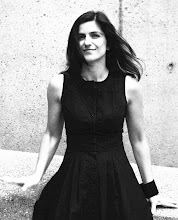from performance to architecture: Marina Abramovic part 3
Marina
Abramović started her presentation (or performance?) by explaining the reasons behind her need to create legacy. For Abramović there is not big difference to create few more shows (especially after exhibiting at MOMA) but it is more important to think of other formats in which she can transfer her 40 years of experience. Abramović also explained the need to have her name on the Insitute, both as a brand to raise money, but also to secure the type of performance that will take place there.
Abramović addressed the role of the artist in society and specifically how this has transformed the last years, from a "disturbed bohemian guy with dirty clothes" (in different venue she has described herself as an artist wearing black, dirty clothes) towards a person that has many responsibilities and clear functions within society. For Abramović, art should not occur in the nature (which she finds perfect) but in the "disturbed societies."

For Abramović, performance art's role and the Institute's role is "to unconditionally give to your own public and society." More specifically the Institute needs to really address the immaterial forms of art, starting with music, then performance, then opera, then theater, then video, then film, and following with new forms not yet predicted. In performance, time is important. When you enter the Institute, you need to sign a contract, to give your word of honor that you are staying 6 hours. You cannot leave. As Abramović says: "You give me your word of honor, I give you an experience. It is a fair exchange."

Once you enter the Institute you abandon your belongings (eg. laptop, cellphone etc) and you wear a uniform. The Institute is like a lab in a way. When you start your training, you enter different chambers to experience different situations, like the crystal chambers, according to Abramović crystals have memory, chamber with magnetic beds, and so on). There is a slight complication with the bathrooms for which they design three types: for women, for men, and for artists.



To further highlight her point about the need for time and long duration in performance, Abramović brings historical examples in which she mentions the duration and the preparation (and transformation) of the artist. She starts from Richard Wagner, Stockhausen, John Casem to Pina Bausch, Douglas Gordon, Robert Wilson, David Lavine, Terence Koh, herself, Tehching Hsieh.
Tehching (Sam) Hsieh, is an artist, whom Abramović characterized as master. In One Year Performance, Hsieh transformed his studio into a cage which he would not allowed (himself) to leave. A friend would bring him food every day. From their discussions she recalls that after one year the whole space has completely change. For example, when you sit on the bed on the far left corner, this is the sleeping room, when you sit in the middle this is the sitting area, when you sit in the far rigth edge this is the garden. In various occasions in her talks (not only in this lecture) Abramović suggest something similar (but obvisouly less extreme), the experiment with opening and closing the door. She explains, to open the door and leave, or to open the door and close it, or to open it half way, it is a very different experience. This is when the door becomes space. One could say that her New York piece, House with the Ocean Views, where she stayed in the stage for 12 days without food, exposed to the public, follows similar concepts and it is influenced by such practices like Hsieh's. She showed many examples of his work. Abramović once asked Hsieh: "What are you doing now?" and Hsieh replied: "I am doing life." Then she explained to the audience, in art you keep doing more projects in order to achieve things you had not been able to complete in the previous projects. However she differentiated Hsieh from this by acknowledging the stage of completion in which he has arrived in his work. So Hsieh, according to Abramović does not need to perform anymore, he just does life. 

Performance art for Abramović is a time-based art, a living type of art, and an immaterial form of art. During the Abramović experiment, people commit to time; they learn many things about their body like for example not to cross their legs because this blocks circulation. The Abramović method includes the learning of three objects/ positions: standing, sitting, and lying.

To further study immaterial art Abramović went to Brazil to research two kind of things: places of power and people of power. Abramović believes in the transmission of energy that naturally happens in places like the waterfalls, volcanos, and other natural fields, and she compared this with some people's power to extract this energy from the environment, through spirituality, and give it back to people in order to heal them. Much of this research will part of her upcoming "The current" movie. In one of her videos (not in this lecture), Abramović explained how she synchronizes her performances with the moon cycles in order to utilize its ability to move ocean and therefore body waters.
Questions from the audience ocurred around religion, market , toilets, subjectivity and other diverse topics. At the end of the day, one still desires from architecture to acquire this transformative ability performance has. Borrowing Abramović's words: [Performance] it is not about you, it is about the others.
Labels: events, gsd, lectures, performance












0 Comments:
Post a Comment
<< Home